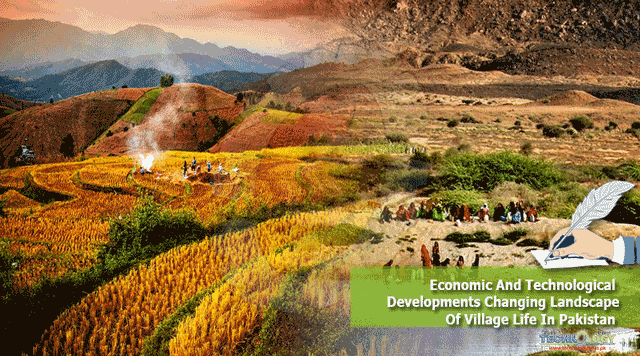The countryside life in far-flung areas of Pakistan, once considered totally isolated and secluded from the rest of the world and devoid of modern-day facilities, has undergone a massive transformation during the last two decades or so by changing the entire landscape of village life.

The rural life is often considered backward, fixed and hostage to tribal culture and traditions. Similarly, the popular social discourse that nothing has changed in Pakistan contradicts with historical facts.
Looking at the national picture of rural life in Pakistan rapid changes have occurred in almost all spheres of life from communication to education, socialization to healthcare, transportation to banking, governance to farming and cultivation to harvesting due to technological advancement, developmental works, penetration of information technology, remittances and domestic tourism.
Among others, the two factors of economic and technological developments as the agent of change had proved instrumental in shaping the process of change not only in the urban areas but also in suburbs of the country. Not more than twenty years ago when mobility was considered difficult in the remote areas not only due to missing road infrastructure but also due to poor transportation facilities.
‘Tonga,’ a carriage pulled by a horse, was the only facility for public transport while bullock-cart was commonplace phenomena for weight transportation in almost all small villages. The houses made of mud have also slowly been replaced by cemented buildings while the social structure was also changed due to disintegration of combined family structure to separate family system.
Likewise, only a few professions of handicrafts have survived due innovation to capture the pace of time and demand of the market while others have totally faded away. Similarly, the obsolete tools, techniques and methods are no more used in farming, cultivation and harvesting due to low production. Therefore, it could not survive at all in the face of modern technologies.
The media revolution in the country with more than 100 private TV channels has brought the whole world at the doorstep of the villagers while the mobile phone companies and 3G/4G technologies have brought it further closer to the palms of people. Hardly there is anyone left without having a smartphone even in the remotest parts of the country.
Almost everybody has got access to the unbridled flow of information on social media in every nook and corner of the country. Thus the electronic media and communication technologies have brought together the collective experiences of the whole world into rural households. The occupation and profession in rural areas once used to be farming and handicraft only. Now village life in pakistan it has also transformed into government services, urban migration, overseas workers and businesses. The migrant workers are not only bringing money to the rural economy, but also ideas and experiences about how people in urban areas and the world outside live.
The villages, the basic components of civilization, where a large segment of society is living, have either transformed into model villages/towns or merged with nearby cities having urbanized lifestyle and lots of hustle and bustle. But in developed parts of the globe, the difference between village and city life is still quite visible due to well-planned construction, proper waste disposal mechanism, sewerage system, cleanliness and greenery.
Talking to this agency, Sajjad Ali, a businessman hailing from a remote town Sawal Dher, Mardan, said, The villages were rapidly expanding due to uncontrolled population growth. He said that the fertile land, once used only for cultivation purposes, had turned into business hubs for housing societies. The construction was also carried out without planning, he added.
Fawad Yousafzai, an Islamabad based working journalist while talking to the agency said, With modernization, no safeguard measures were taken to protect public health against the waste disposal. Therefore, over the years, the ill-planned construction in agricultural lands and lack of sewerage system had affected the overall beauty of village life, he added.
